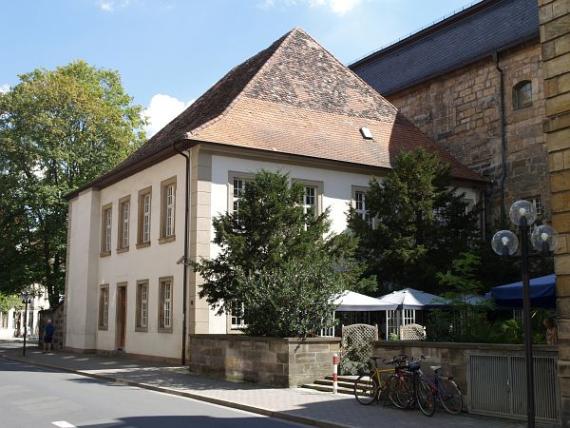Münzgasse 2
95444 Bayreuth
Germany
On Sabbath Para 5520 = March 15, 1760 the synagogue in Bayreuth was consecrated. Already earlier Jews had lived in Bayreuth. Around the middle of the 13th century they had settled here and in 1515 they were forced to emigrate. Remains of the old Jewish settlement no longer exist, only one street is popularly called 'Judengasse', perhaps in memory of past times. Individual Jewesses*Jews were later allowed to move in especially if their services were needed.
Margrave Frederick, whose wife was the sister of Frederick the Great, had a Jewish court painter, and several Jewish court actuaries and agents. In 1759, he gave his 'court and coin supplier' Moses (Moyes) Seckel from Bruck permission to settle 10 Jewish families, establish a community and build a synagogue. Thus, the year 1759 is the founding year of our current congregation.
On March 5, 1759, Moses, together with his brother David, purchased 'the old Comoedien- und Redouten-Hauss' for the price of 8,520 Rheinische Gulden and had it converted into a synagogue at his own expense. On the south side, facing the new opera house and separated from it only by a narrow corridor, we still find the old wall and the old form with four large round windows, later bricked up. Vanini is named as the master builder of the synagogue. It is in Margraviate Baroque style; the women's gallery rests on eight massive marbled wooden columns. Although the interior of the church has undergone many changes over the years, the holy ark (Fig. 1) still shows its original beautiful form. The circular section above it is decorated in honor of the founder Moses, son of Seckel from Bruck, and his wife Feigle, daughter of Joel from Schwabach, an inscription that tells us the date of dedication.
To the nobility of the couple we also owe a valuable curtain adorned with magnificent embroidery, which is the work of the gold embroiderer Jospe in Baiersdorf. His father already practiced the same craft, as he is mentioned with the name Moyses Goldstücker already in the letters of protection 1709 and 1712. The prayers for the sovereign, Margrave Friedrich and his wife, in Hebrew and German (picture 2 and 3) were written on parchment by the artist J.J. Köppel in 1760 and decorated with particularly beautiful coat of arms drawings. These artistically outstanding hand pen drawings were also probably donated by Moses Seckel.
The synagogue initially remained the property of the donor and was made available to the community free of charge. Only his brother and heir, the court agent David Seckel, then gave it to the community as property in 1772.
The first ten families, who now moved from Baiersdorf to Bayreuth, had to prove their favorable property situation. The document states: "Every Jew seeking protection here must possess at least 4-500 gulden fr. of his own property and must therefore prove his legitimacy before the reception by means of a certificate to be provided by the rabbi and head parnoss."
The synagogue, which was demolished during the Nazi era, was first renovated in 1946 and has since been used again by the Jewish community as a religious center for services and celebrations.
In 1964 to 1965, a reconstruction and redesign of the prayer room took place according to the plans of architect Hermann Zvi Guttmann. At that time, according to the instructions of the head of the Palace Administration, the round-arched windows were replaced by rectangular windows, so that the house is not immediately recognizable as a synagogue in the neighborhood of the Opera House.
Since 2012, the synagogue has been undergoing extensive renovation. As the oldest baroque synagogue in Germany, it is considered a nationally significant architectural monument. In connection with the renovation, the ritual bath (mikvah) was first renovated. It is fed by an (artesian) well whose water can be fed into the basin from a depth of 70 meters without a pump. It is considered the purest in Europe, according to a verdict of the London rabbi Meir Posen. After the inauguration of the mikvah on August 16, 2013, renovation work on the synagogue began. The building will undergo core renovation. The entrance will be moved to the west side. The round-arched windows on the west side - towards the Redoutenhaus - will be restored. The plans for the reconstruction of the synagogue were drawn up by the architects Wandel, Hoefer, Lorch + Hirsch from Saarbrücken, who were also responsible for the synagogue buildings in Dresden, Munich and Cologne.
After extensive renovation, the synagogue will reopen in spring 2018. From March 2018, numerous events in the religious and cultural field will take place over an anniversary year.


Add new comment